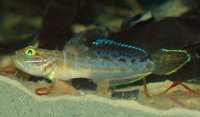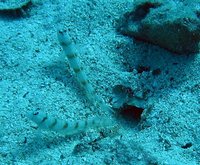Goby
|
|
| Gobies | ||||||||||
|---|---|---|---|---|---|---|---|---|---|---|
| | ||||||||||
| Scientific classification | ||||||||||
| ||||||||||
| Genera | ||||||||||
|
Many, e.g. |
The Gobies form the family Gobiidae, and are one of the largest families of fish, with over 2000 known species. Most are relatively small, typically less than 10 cm in length. The smallest vertebrates in the world are gobies of the genera Trimmatom and Pandaka, which are under 1 cm long when fully grown. There are some large gobies, such as species of Gobioides, that can reach well over 30 cm in length, but that is exceptional. Although few are important as food for humans, they are of great significance as prey species for commercially important fish like cod, haddock, sea bass, and flatfish. Several gobies are also of interest as aquarium fish, in particular the bumblebee gobies of the genus Brachygobius.
The most distinctive aspect of goby morphology are the fused pelvic fins that form a disc-shaped sucker. In function this sucker is analogous to the dorsal fin sucker possessed by the remora or the pelvic fin sucker that the lumpfish has, but is anatomically a quite distinct structure, and thus any similarities are the product of convergent evolution. Gobies can often be seen using the sucker to adhere to rocks and corals, and in aquaria they will happily stick to glass walls of the tank as well.
Gobies are primarily fish of shallow marine habitats including tide pools, coral reefs, and seagrass meadows; they are also very numerous in brackish water and estuarine habitats including the lower reaches of rivers, mangrove swamps, and salt marshes. A small number of gobies (unknown exactly, but in the low hundreds) are also fully adapted to freshwater environments. These include the Asian river gobies (Rhinogobius spp.), the desert gobies of Australia (Redigobius), and the European freshwater goby Padagobius martensii.
Rhinogobiusduosp.jpeg
| Contents |
Mudskippers
Highly specialised members of the family are the the mudskippers, usually ascribed to the subfamily Oxudercinae; these gobies are able to survive for extended periods on land through a combination of behavioural and physiological adaptations, including pectoral fins that act as simple legs; the ability to breathe through their skins (like frogs); and the digging of damp burrows to avoid drying out.
Periophthalmus argentilineatus (= Periophthalmus barbarus) is one of the most widespread mudskippers and can be found in mangroves and mudflats of East Africa and Madagascar east through South East Asia to Australia and Japan. It grows to a length of about 15 cm and feeds on small crabs and other crustaceans. It will also eat mosquito larvae and small fish that it can catch.
Symbiosis
Some goby species live in symbiosis with burrowing shrimps. The shrimp maintains a burrow in the sand in which both the shrimp and the goby fish live. The shrimp has poor eyesight compared to the goby, but if it sees or feels the goby suddenly swim into the burrow, it will follow. The goby and shrimp keep in contact with each other, the shrimp using its antennae, and the goby flicking the shrimp with its tail when alarmed. These gobies are thus sometimes known as 'watchman gobies'.
Another example of symbiosis is demonstrated by the neon gobies (Gobiosoma spp.). These gobies are cleaner fish, and remove parasites from the skin, fins, mouth, and gills of a wide variety of large fish. The most remarkable aspect of this symbiosis is that many of the fish that visit the cleaner gobies' cleaning station would otherwise treat such small fish as food (for example groupers and snappers).
Sleeper Gobies
Sleeper gobies belong to the family Eleotridae that is closely related to the Gobiidae. Like the true gobies they are generally small, mostly marine fish that live on the substrate, often amongst vegetation, in burrows, or in crevices within rocks and coral reefs. Although goby-like in many ways, sleeper gobies lack the pelvic fin sucker, and together with other morphological differences, is used to distinguish the two families. It is widely believed that the Gobiidae and Eleotridae share a common ancestor, and they are both placed in the order Gobioidei, along with a few other small families containing goby-like fishes.
Dormitator and Eleotris are two of the most widespread and typical genera, including a variety of species that inhabit marine, estuarine, and freshwater habitats. Dormitator maculatus for example grows to about 30 cm and is widely found in brackish and shallow marine waters of the South Eastern United States and Mexico. There are some predatory sleeper gobies that get much bigger, such as the marbled sleeper goby, Oxyeleotris marmorata, a freshwater species from South East Asia that can grow up to 60 cm long. However, most are much smaller, such as the fresh and brackish water species from Australia like Hypseleotris spp., known locally as "gudgeons" (not to be confused with the Eurasian freshwater cyprinid Gobio gobio, also known as the gudgeon).
See also
- List of fish common names
- List of fish families
- Dragonet (a similar family often confused with gobies)
External link
- FishBase entry on Gobiidae (http://www.fishbase.org/Summary/FamilySummary.cfm?ID=405)
- Gobioid Research Institute (http://www.gobiidae.com)
- Takahiko Mukai's Encyclopaedia of Goby (mostly Japanese) (http://homepage2.nifty.com/PhD-mukai/)
- Richard Mleczko's Mudskipper & Goby Page (http://www.ozemail.com.au/~thebobo/goby.htm)
- Article on cleaner gobies in aquaria (http://www.wetwebmedia.com/clnrfaqs.htm)
- Brackish Water Aquarium FAQ entry on gobies (http://homepage.mac.com/nmonks/aquaria/brackfaqpart6.html#gobiidae)da:Kutlingefamilien


